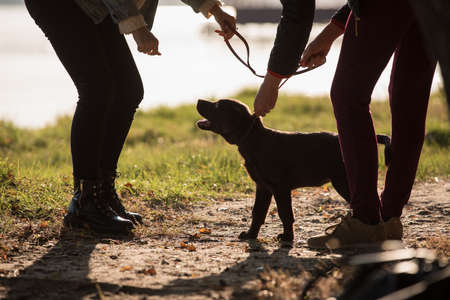1. Introduction to Year-Round Dog Walking in the UK
There’s something truly special about taking your dog for a walk across Britain’s ever-changing landscapes, whatever the season. From frosty mornings on the village green to sun-dappled strolls through ancient woodlands, walking your dog all year round offers not only essential exercise but also moments of pure joy and connection with nature. The UK’s unique blend of rolling hills, picturesque coastlines, and bustling parks ensures every walk is an adventure, whether you’re braving a brisk Scottish breeze or basking in the rare warmth of an English summer. As the seasons shift, so too do the sights, smells, and experiences that greet you and your canine companion—making each outing a fresh opportunity to bond and explore together. Embracing the great British outdoors, come rain or shine, keeps both you and your dog healthy, happy, and wonderfully attuned to the rhythms of local life and weather.
Spring Adventures: Watching for Wildlife and Allergens
As the days grow longer and the UK’s parks and countryside burst into bloom, spring offers the perfect backdrop for dog walking. However, this vibrant season also brings unique challenges for both you and your canine companion. By understanding the risks and making small adjustments to your routine, you can enjoy the best of British springtime while keeping your dog safe.
Enjoying Blooming Parks and Countryside
Spring is renowned for its carpets of bluebells, daffodils, and other wildflowers across the UK. While these scenes are picturesque, some popular seasonal plants can be harmful to dogs if ingested. Below is a quick reference guide to common spring hazards:
| Hazardous Plant | Where Found | Symptoms if Ingested |
|---|---|---|
| Daffodils | Parks, gardens, roadside verges | Vomiting, drooling, abdominal pain |
| Bluebells | Woodlands, shaded areas | Nausea, diarrhoea, heart irregularities |
| Lilies | Parks, floral displays | Lethargy, vomiting, kidney issues |
Tips for Safe Springtime Walks
- Keep your dog on a lead in unfamiliar areas where hazardous plants may be present.
- Discourage your dog from digging or chewing unknown foliage.
- If you suspect your dog has eaten something toxic, contact your local vet immediately.
Navigating Increased Wildlife Activity
The arrival of spring means more wildlife activity—nesting birds in hedgerows, rabbits dashing across fields, and even foxes roaming suburban areas. This can tempt even the most well-behaved dogs to chase or disturb animals.
How to Manage Wildlife Encounters
- Use a long training lead to give your dog freedom while maintaining control.
- Avoid letting your dog off-lead during dawn or dusk when wildlife is most active.
- Practice recall commands regularly to ensure your dog returns promptly when called.
- If you spot signs for ground-nesting birds (common on National Trust land), stick to marked paths with your dog close by.
Tackling Allergens and Pollen
Pollen counts soar in spring, affecting both humans and pets. Dogs can develop itchy skin or watery eyes due to pollen exposure.
- Wipe your dog’s paws and coat after walks to remove pollen.
- If allergy symptoms persist, consult your vet for tailored advice or medication.
With a little forward planning and awareness of seasonal changes, you can turn every spring walk into a safe and joyful adventure for both you and your four-legged friend.

3. Summer Strolls: Beating the Heat and Avoiding Overexertion
As summer arrives in the UK, dog walks become a wonderful opportunity to embrace longer days and the beauty of nature in full bloom. However, British summers can bring unexpected heatwaves and muggy afternoons that may catch you and your canine companion off guard. It’s essential to adapt your walking routine to keep your dog cool, comfortable, and safe.
Timing is Everything
On warmer days, try to schedule walks during the early morning or later in the evening when temperatures are milder. Avoid midday strolls when the sun is at its peak, as pavements can become scorching underfoot—a real hazard for sensitive paws. A quick test with your hand on the pavement will help you decide if it’s too hot for your dog.
Keeping Your Dog Hydrated and Cool
Always carry fresh water and a portable bowl for your dog, offering frequent drinks throughout your walk. Seek out shaded routes, such as wooded trails or parks with mature trees, to provide natural shelter from the sun. Consider using cooling coats or bandanas, which are readily available in UK pet shops, for extra protection during particularly hot spells.
Recognising Signs of Overheating
British dogs aren’t always accustomed to extreme heat, so watch for signs of overexertion such as excessive panting, drooling, or lethargy. If you notice any of these symptoms, stop immediately and find a cool spot to rest. If your dog’s condition doesn’t improve quickly, seek veterinary attention without delay.
Protecting Against Ticks and Sunburn
Summer also means an increase in ticks across British countryside areas. After each walk, especially through fields or woodlands, check your dog thoroughly for ticks—pay special attention to ears, armpits, and between toes. Additionally, light-coloured or short-haired dogs may be at risk of sunburn; apply a pet-safe sunscreen to vulnerable areas like noses and ear tips if needed.
Top Tip:
If you fancy a pub garden visit after your walk, ensure there’s plenty of shade and water available for your dog while you enjoy a refreshing drink yourself—after all, it’s what summer strolls in Britain are all about!
4. Autumn Outings: Navigating Mud, Leaves and Bonfire Night
Autumn in the UK brings a wonderful tapestry of colours, fresh air, and the unmistakable crunch of leaves underfoot. However, this season also presents unique challenges for dog walkers. Here’s how you and your furry companion can make the most of autumn adventures while staying safe and comfortable.
Embracing Crisp Walks
The brisk autumn weather is ideal for invigorating walks. Take advantage of quieter parks and scenic woodland trails, but remember to dress appropriately with layers and waterproofs. Dogs often love the cool temperatures, so consider exploring new routes to keep things interesting for both of you.
Managing Muddy Conditions
With increased rainfall, muddy paths are inevitable. To keep your home and car clean after a walk, carry a towel or doggy wipes. Consider investing in a waterproof dog coat and booties for breeds prone to cold or sensitive paws. Below is a quick guide to managing muddy outings:
| Muddy Situation | Practical Solution |
|---|---|
| Paws caked in mud | Rinse with warm water at home or use portable paw washers |
| Muddy coats | Towel dry thoroughly before entering the house |
| Mud indoors | Use washable rugs by doors and limit access until clean |
Being Mindful of Leaf-Covered Hazards
Fallen leaves can hide hazards such as uneven ground, sharp objects, or even fungi that are toxic to dogs. Always keep a close eye on where your dog is sniffing or digging. Try to stick to well-trodden paths when visibility is poor, and discourage eating anything found among the leaves.
Bonfire Night: Keeping Your Dog Calm During Fireworks Season
Bonfire Night (5th November) and other autumn celebrations often mean fireworks—anxiety-inducing for many dogs. Here are some tips for keeping your pet calm:
| Challenge | Coping Strategy |
|---|---|
| Loud bangs from fireworks | Create a safe den at home with familiar blankets and toys; play calming music to mask noise |
| Anxious behaviour during walks | Walk earlier in the day when fireworks are less likely; use a secure lead and harness |
| Panic or attempts to bolt | Keep ID tags up-to-date; consider using a GPS tracker on their collar for extra peace of mind |
Helpful Reminders for Autumn Walks:
- Keep dogs visible with reflective gear as daylight hours shorten.
- Watch out for antifreeze spills (toxic if ingested) on driveways.
- Check paws after every walk for cuts or debris hidden by mud or leaves.
- If your dog gets anxious during fireworks, consult your vet about anxiety aids or pheromone diffusers.
A Positive Autumn Adventure Awaits!
With mindful preparation, autumn dog walks can be both enjoyable and safe. Embrace the season’s beauty while keeping hazards at bay—your dog will thank you for it!
5. Winter Walks: Staying Safe in the Cold, Dark, and Snow
Adapting to Shorter Days and Longer Nights
As winter settles across the UK, dog walking presents unique challenges due to shorter daylight hours. It’s best to plan your walks during the brightest part of the day, usually between 10am and 3pm. If you must venture out when it’s dark, equip yourself and your dog with reflective gear or LED collars to enhance visibility. Remember, rural lanes and even city parks can become shadowy and tricky to navigate after dusk.
Dealing with Frosty Surfaces and Gritted Roads
Icy pavements and frosty grass are common hazards during British winters. Always choose well-trodden paths where possible, as these are less likely to conceal hidden ice patches. Be mindful of gritted roads—while they help prevent slipping, the salt can irritate your dog’s paws. After every walk, gently wipe their feet with a damp cloth to remove any residue and check for cracks or soreness.
Keeping Your Dog Warm and Comfortable
Not all dogs are built for the British chill. Short-haired breeds or older pets may need an extra layer; consider investing in a good-quality dog coat that covers their belly as well as their back. For smaller pups or those sensitive to the cold, limit the length of outdoor excursions and ensure they warm up indoors afterwards.
Visibility Matters for Both Owner and Pet
The low winter sun and early sunsets mean drivers have reduced visibility too. Always keep your dog on a lead near roads and use high-visibility jackets for yourself. Choose brightly coloured leads, harnesses, or flashing accessories so both of you stand out against the wintry landscape.
Embracing Winter Adventures Safely
Despite the challenges, winter walks can be magical—a crisp morning stroll through frost-covered fields is a joy for both humans and hounds. By preparing thoughtfully and embracing seasonal precautions, you’ll ensure your dog stays safe, warm, and visible throughout Britain’s chilliest months. This way, you both continue enjoying the great outdoors together all year round.
6. Essential Kit and Local Considerations for UK Dog Walkers
Stepping out for a dog walk in the UK means being prepared, not just for the unpredictable weather but also for local customs and regulations. Here’s what every responsible British dog owner should know before heading outdoors with their canine companion.
Must-Have Gear for All Seasons
No matter the season, having the right kit makes walks safer and more enjoyable. Always carry sturdy leads, a well-fitted harness, and reliable poo bags—leaving no trace is a must across the UK. Waterproof jackets (for both you and your dog), reflective gear for low light, collapsible water bowls, and treats are essential to keep your dog happy and hydrated. In rural areas, check for ticks after walks and consider booties if venturing onto rough or icy terrain.
Understanding Local Etiquette
Polite dog walking behaviour goes a long way in British parks and countryside. Always greet other walkers with a friendly nod or “hello.” If your dog is off-lead, ensure strong recall and be ready to leash them when approaching livestock, wildlife, or nervous dogs. Dispose of waste in provided bins and avoid letting your dog disturb others—especially children, picnickers, or those working on the land.
Countryside Code & Public Footpath Rules
The UK’s Countryside Code outlines key principles: respect everyone, protect the environment, and enjoy the outdoors responsibly. Stick to marked footpaths, close gates behind you, and keep dogs under close control—particularly around farmland. Many rights of way cross private property; always give way to farmers and be mindful during lambing or nesting seasons.
Useful Resources for British Dog Walkers
Stay informed by checking resources like The Kennel Club’s Good Citizen Dog Scheme, local council websites for park rules, and the Ramblers Association for public footpath maps. Download mobile apps that highlight walking routes and any temporary restrictions due to wildlife or farming activities.
A Final Word on Preparation
Being well-equipped and aware of local guidelines transforms every walk into an adventure that’s safe, respectful, and rewarding for both you and your dog. Embrace the rich tradition of British dog walking while setting an example others will want to follow.
7. Embracing the British Outdoors: Building Healthy Habits Year-Round
In true British fashion, we know that the weather can be as changeable as a pups mood—drizzle one moment, sunshine the next! But rather than seeing rain, wind, or chilly mornings as obstacles, consider them invitations to explore the UKs beautiful green spaces in all their seasonal glory. Whether you’re strolling through a frosty park in winter, enjoying bluebells in spring, picnicking under shady trees in summer, or crunching leaves on an autumn ramble, every walk is an opportunity to connect with your dog and the landscape around you.
Establishing a daily walking routine—come rain or shine—not only benefits your dog’s physical health but also boosts your own wellbeing. The act of stepping outside, even for a short wander, helps clear the mind and fosters a sense of community as you greet fellow walkers (with a friendly “Morning!” or “Alright?”). The UK’s network of footpaths, commons, and dog-friendly parks means there’s always somewhere new to discover together. Don’t let a bit of mud or mist put you off; invest in a sturdy pair of wellies and a waterproof jacket for yourself, and perhaps a cosy coat for your four-legged friend if needed.
By embracing all weathers and maintaining consistency, you’ll nurture positive behaviours in your dog and build resilience in yourself. Over time, these shared outdoor adventures become treasured rituals—moments to pause, reflect, and celebrate the simple pleasures of life with your canine companion. So next time those grey clouds roll in or the wind picks up across the fields, remember: it’s just another brilliant excuse to head out and make memories. After all, there’s no such thing as bad weather—only unsuitable clothing!


